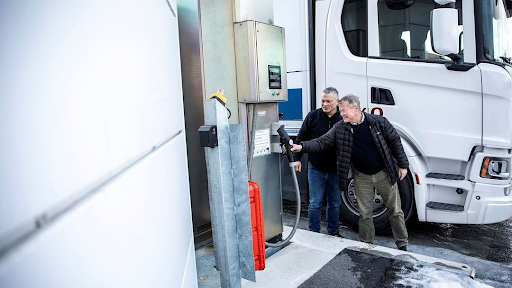Transporting hydrogen along roads leads to high costs in money and for the environment.
In a sparsely-populated country like Norway, we should invest in several small local hydrogen production plants based on electrolysis of water. Transport costs are considerable, and will very likely lead to demands for transport support if we base the construction of future infrastructure on models from densely-populated countries and large plants.
We can, for instance, compare ourselves with Denmark, which has roughly the same population as Norway. The Danes have less than 400km distance between their northernmost and southernmost points, and 300km between the easternmost and westernmost. In Norway, the distance between Lindesnes and the North Cape is 1,680km as the crow flies.

From a central supply point on Jutland, the Danes can easily reach every corner of the country by car in a few hours. In Norway, we must think differently and focus on small-scale production sites near to consumption.
Transport of hydrogen is expensive. GreenH AS has estimated how much it costs to transport hydrogen by road. Freight costs would be 60 øre per kWh or 20 kroner per kilo of hydrogen if transported 500km in gas form. Transport costs for a maximum load with liquid hydrogen would come to about 11 kroner per kilo.
By producing green hydrogen directly through electrolysis of water instead of from gas, the choice of production site becomes freer. The production can be put in a hub close to the biggest users of green hydrogen. Hydrogen production and bunkering facilities can, for example, be placed on the docks, and the necessary energy transported by electric cables to the plant.
Hydrogen is light. It is the packaging that is heavy. Internationally, the transport and distribution of large volumes of hydrogen for industrial use has occurred through pipelines from the factory. Globally, there are more than 4,000km of hydrogen pipelines, but in Norway we have few such opportunities.
With smaller volumes, hydrogen is transported on country roads. Hydrogen in gas form is transported in high-pressure tanks and liquid hydrogen in cryogenic tanks where the temperature must be kept lower than minus 253 oC.
Hydrogen transport is largely about moving steel. According to “Hydrogen Europe”, the biggest tank volume for transport of pressurised hydrogen is 26 m 3 (500 bar). This tank can contain about 1,100kg of hydrogen in gas form. The empty tank weighs more than 20 tonnes, or about 20 times the weight of the hydrogen in the tank.
For liquid hydrogen, up to 3,500kg can be transported with a tank of 50 m 3. The empty “thermos flask” and frame will weigh about 35 tonnes. So we are talking about a vehicle on the road with a combined weight of more than 40 tonnes.
It requires a significant amount of energy to tow 40 tonnes on possibly bad roads. Hydrogen transport along country roads thus leads to high costs in money and for the environment through emissions.
We are best served by decentralised production solutions, near to the biggest first users when we are setting up a domestic infrastructure for the distribution of green hydrogen. This will give lower costs, be quicker to set up, and cause less environmental impact. Or said in another way: good for the consumer, good for Norway, and good for the environment.
For the record: GreenH AS develops infrastructure and production plants for “green” hydrogen.
